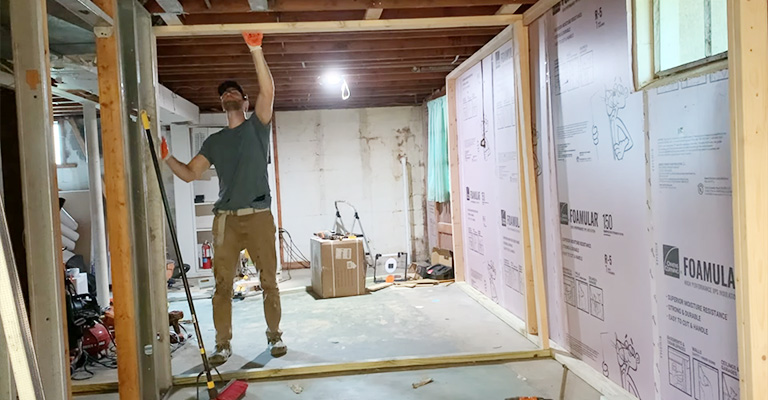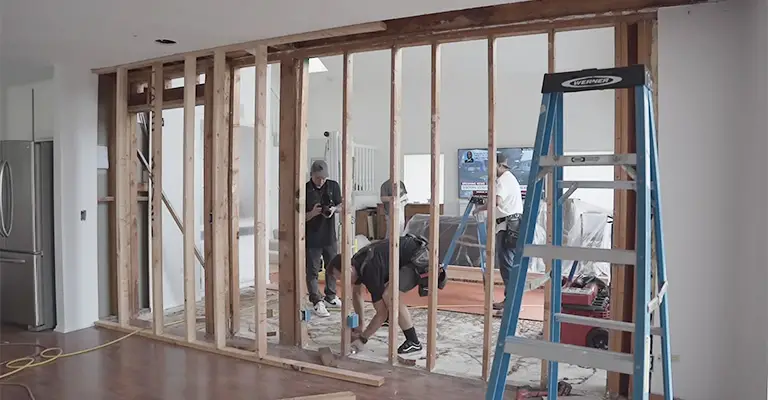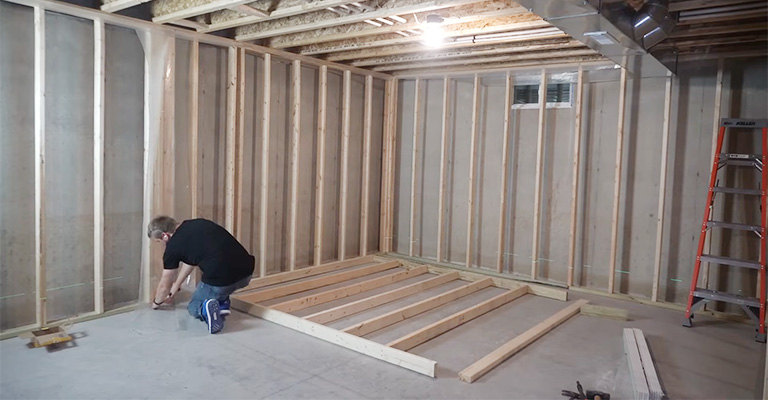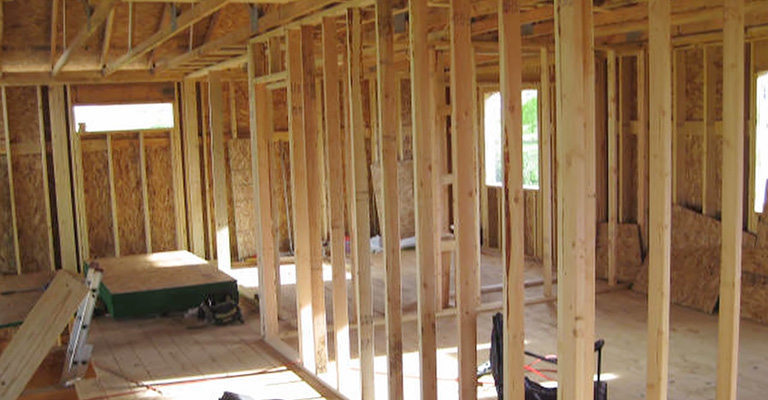Adding an interior wall to your home is often driven by a desire for increased functionality, privacy, or aesthetic appeal.
However, before you start framing and drywalling, an important question is: Do you need a permit to add an interior wall?
It is necessary to obtain a permit if you intend to build a wall, remove a wall, or even change the height of a wall.
Home renovation projects often come with various regulatory considerations, and interior wall construction is no exception.
There is no difference between a load-bearing wall and one that is not.
Permit Required To Add Interior Wall
Renovating the support beams, columns, etc., and changing a building’s facet/footprint via expansion and reduction generally requires a permit.
In general, permits are unnecessary for interior work not involving main support components or framing.
There is no need to change the “use” of a building unless you do so to be permitted to do so. Nonetheless, it is recommended to have a structural engineer or architect review your plan to ensure the integrity of the building structure.
However, based on the language of the Ohio Building Code cited below (article 105.1), constructing an interior wall can be considered an “alteration” to a residential structure or building, even though it is not explicitly listed as such.
You need to check with your local building authority or architect if you want clarification.
It is worth noting that a building has two types of walls. Load Bearing Walls. Generally, a partition wall does not support weight.
An inspection will usually be conducted after work is completed to ensure that the approved plan is followed. However, the permit-issuing agency can let you know which stages require inspection.
The Reason You Need Permission

The purpose of a building permit is valid, even though it may appear like government red tape. By following building codes and personal safety regulations, anyone who does the work is ensured to stay safe.
If your job requires plumbing, HVAC, or electrical work, that’s particularly true. When a building permit is obtained, someone is in charge of ensuring everything is done correctly.
There may be another reason related to your property value. Municipalities will likely increase your taxes if you increase them. However, it isn’t just an excuse to get more money from you.
In addition, you will need to keep it in mind if you plan to sell your house. Unpermitted construction could delay your sale or adversely affect your sale price. Keeping to the letter of the law is, therefore, the best course of action.
Also, a building permit won’t cost you much if you’re doing something not so significant.
Excerpt from the 2017 Ohio Building Code:

“102.10.2 Minor repairs.
Minor repairs to structures may be to residential structures made without application or notice to the residential building official.
Such repairs shall not include the cutting away of any wall, partition or portion thereof, the removal or cutting of any structural beam or load-bearing support, or the removal or change of any required means of egress or rearrangement of parts of a structure affecting the egress requirements; nor shall ordinary repairs include addition to, alteration of, replacement or relocation of any standpipe, water supply, sewer, drainage, drain leader, gas, soil, waste, vent or similar piping, electric wiring or mechanical or other work affecting public health or general safety.
105.1 Approvals required.
Any owner or authorized agent who intends to construct, enlarge, alter, repair, move, or change the occupancy of a residential building or structure, or portion thereof, or to erect, install, enlarge, alter, repair, remove, convert or replace any electrical, gas, mechanical, plumbing system, other residential building service equipment, or piping system the installation of which is regulated by this code, or to cause any such work to be done, shall first make application to the residential building official of a certified residential building department and obtain the required approval.
Exterior or Interior
It is essential to consider whether it is safer to build an exterior wall or an interior wall.
When you do the former, you are undoubtedly modifying the footprint of your home, which will require a building permit in most cases, especially if it’s a load-bearing wall.
A permit is also needed if there is going to be an addition of a window or egress. It may be tempting to think that an interior wall can get away with it.
However, most construction projects aren’t quiet, especially since it’s not a very quiet business. An inspector will arrive at your door after only one complaint.
Do I Need A Permit For Everything I Do To My Home?

The requirement for permits does not apply to all items. However, there are still particular building and zoning code requirements for all improvements.
Unless otherwise noted, the following items do not typically require a permit.
- Painting, papering, tiling, carpeting, countertops, cabinets, interior wall coverings, floor coverings, and similar finishing jobs.
- Partitions not bearing on each other, except when such partitions create inhabitable rooms.
- In the case of replacing doors or windows, no structural members are changed.
- Materials and products that are being replaced in-kind.
- Repairs that don’t alter the structural integrity of the building, replace a wall or beam, or make changes to wiring, plumbing, and mechanical systems do not need a permit.
Ultimately, you’ll need to contact your local building department to determine whether your project requires a permit.
Most building officials and plan examiners will gladly exchange information on permit requirements to avoid future code violations.
DIY or Professional Job
In accordance with the National Association of Realtors, 53% of home improvement projects are performed by professionals.
An interior wall may not be the most challenging job, but it still requires specialized equipment, such as a circular saw or miter saw.
Another advantage is that contractors often pull permits for you as part of the project. Building codes will be known to a pro, so they will ensure that the work is done according to specifications.
When it comes to building a wall, more than just nailing things together will do. The spacing between studs must be 16 inches to comply with the code.
Should the inspector discover that the studs are too far apart, you must restore the wall to its original state.
What Happens If I Skip Getting A Building Permit When I Should Have Gotten One?
Leaving remodeling permits unattended may cost you.
You may face fines, the need to redo work, and problems when selling your home if your work is not permitted.
There is a possibility that you will be charged twice for any work done without the proper permits.
Removing drywall so the building inspector can inspect work such as piping, insulation, ductwork, or structural elements behind the walls could be necessary.
Additionally, you may need to redo other work, such as cabinetry, countertops, or tile, that you already paid for and installed.
Future buyers may also discover unauthorized work during an inspection of your house.
In some cases, home inspectors dig up public records about the work done on your house and the improvements you made.
If you don’t document home improvements, like adding a new bathroom or addition, you may end up paying fines and having trouble selling the home. As a result, you may also have difficulty getting homeowners insurance.
In addition, building permits provide consumers with the protection they need. It is required that a contractor be licensed to pull a permit.
Contractors who try to talk you out of getting permits might not have the appropriate licensing, so you shouldn’t hire them.
Hiring an unlicensed contractor risks poor workmanship, job site accidents, and property damage.
Thus, you should hire an experienced and licensed contractor who is properly insured, has the right bonded, and has the proper knowledge to complete the work.
How Much Does Building Permits Cost?
Here’s what happens if you skip getting a permit and the purpose and consequences of not getting one.
Why is there a fee in the first place?
Fees are collected to recover the City’s administrative costs incurred in enforcing codes regarding building, electrical, plumbing, and mechanical permits; applications for zoning; and processing of zoning permits.
Additionally, construction inspection and associated costs, as well as land use activities related to the parcels on which construction is likely to occur, are all considered.
We should not forget that permits are mainly intended to protect public safety, but they can also be a source of revenue for municipalities.
Applying for building permits and paying the appropriate fee before beginning any construction is mandatory. You usually will not need to pull building permits unless you are doing the work yourself.
You will need to have a building permit for any work done on your property, depending on the location and type of work.
Your local building department can provide an estimate of the permit fees you are likely to incur as you plan out your project budget. Permit fees can range from a few hundred to several thousand dollars.
Remember that you will probably need more than one permit (i.e., a building permit, an electrical permit, a mechanical permit, a plumbing permit, etc.).
Typically, permit fees are calculated based on your project’s estimated value or square footage.
Final Words
It is essential to know the facts about the approval and permitting process so that you can complete the project successfully. You don’t need to guess or assume anything.
Contacting your local building department will allow you to find out if you need a building permit. Give them an explanation of your project and work that you intend to do and see whether they will need a permit (and how much it will cost).
Don’t forget to ask any other questions you may have related to your project while you’re at it. Most officials will happily clarify your requirements and discuss your project in more detail with you.








